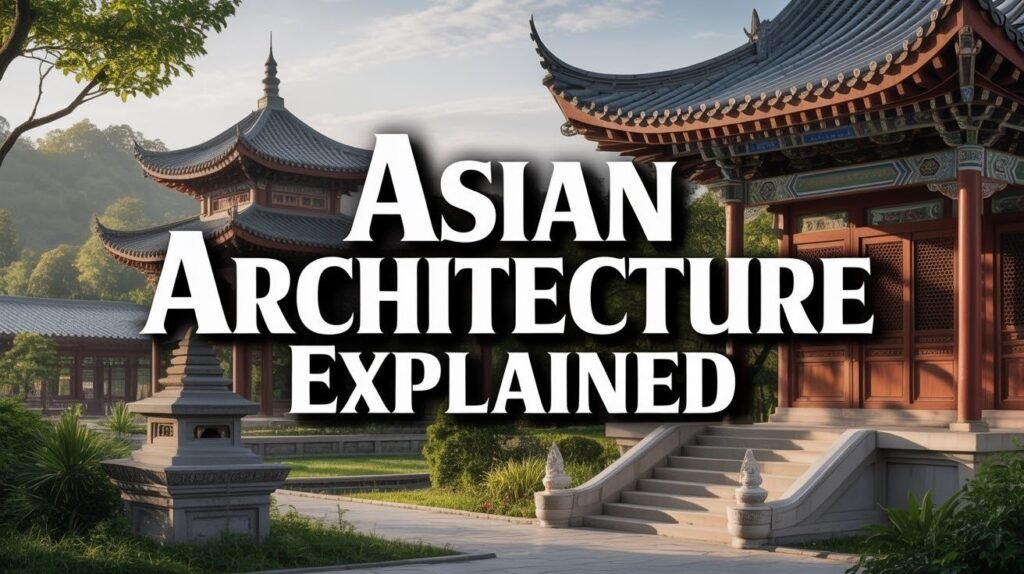I want to take you on a trip through Asia’s incredible buildings. From towering pagodas to ornate temples, Asian architecture tells stories that span thousands of years.
You’ll find buildings that seem to dance with nature. Others rise like mountains reaching for the sky. Each structure carries deep meaning.
It’s not just about creating shelter. These buildings reflect entire worldviews. They show how people connect with their gods, their ancestors, and the natural world around them.
These ancient building methods are surprisingly modern. They solve problems we’re still working on today. Climate control without electricity. Earthquake resistance without steel. Beauty without waste.
In this guide, you’ll learn about the major styles that shaped Asia’s skylines. I’ll show you the symbols hidden in every roof curve and door frame. You’ll understand why certain colors appear again and again.
What Is Asian Architecture?
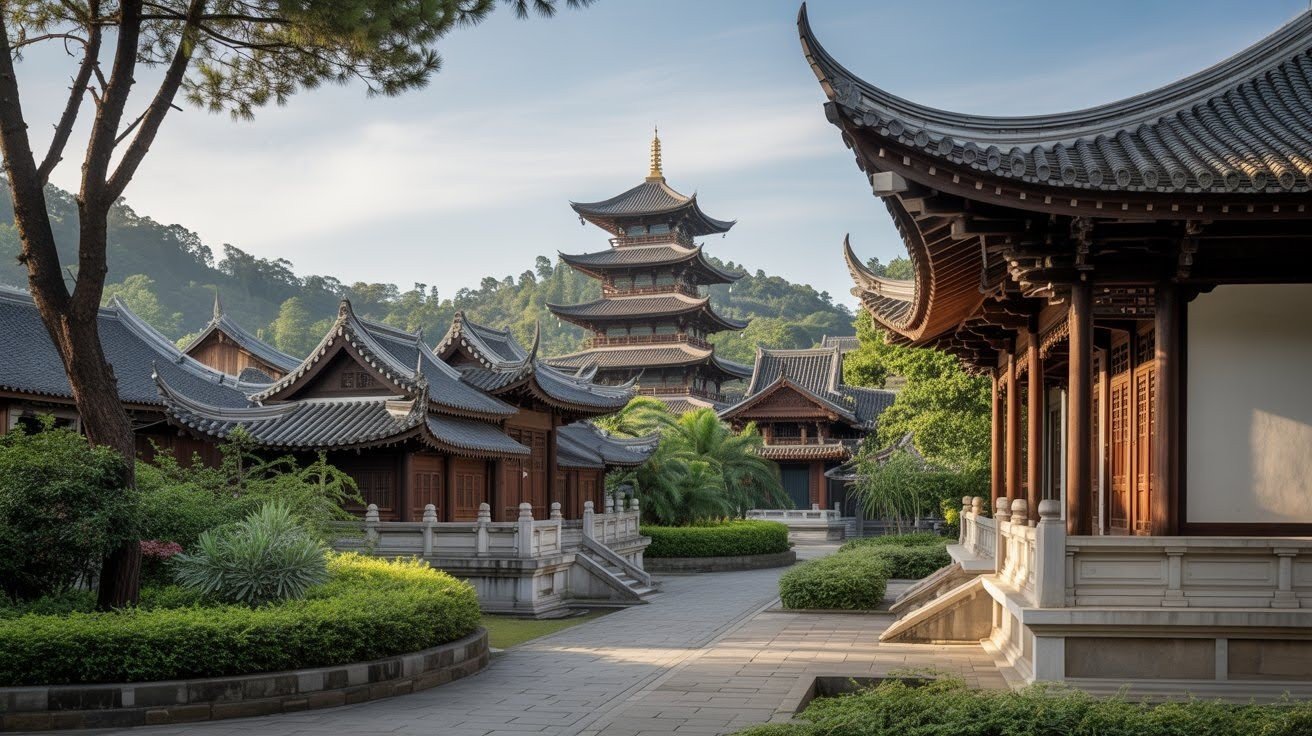
Asian architecture covers a massive area. We’re talking about East Asia, South Asia, Southeast Asia, and Central Asia.
But it’s not just about geography.
These buildings grew from deep spiritual roots. Religion shaped every beam and tile. Philosophy guided every proportion. The environment influenced every material choice.
Unlike Western architecture, which often fights against nature, Asian buildings work with it. They breathe with the seasons. They bend with earthquakes. They cool in summer heat and warm in winter cold.
Major Architectural Styles Across Asia
East Asian Architecture
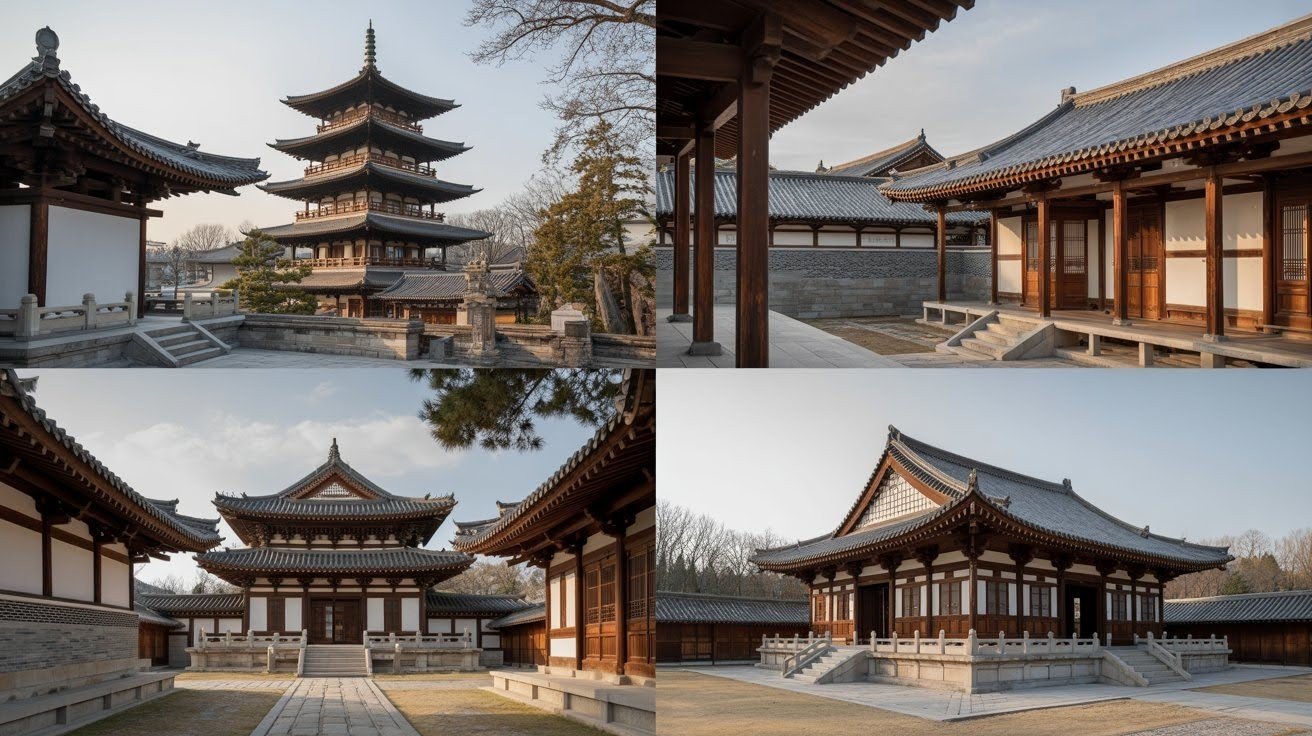
Chinese Style: The Chinese gave us the pagoda. These multi-story towers climb toward heaven in perfect balance. Each level gets smaller as it rises.
Wood joinery is everything here. No nails. Just perfectly cut pieces that fit together like a puzzle. It’s engineering poetry.
Feng Shui guides placement. Buildings face south for warmth. Water features bring good luck. Mountains provide protection from the back.
Japanese Style: Japanese buildings embrace simplicity. Clean lines. Natural materials. Lots of empty space that somehow feels full.
The curved roofs aren’t just pretty. They shed rain and snow. They also lift the spirit upward.
Wood and paper create buildings that breathe. Sliding screens let rooms change size. Gardens become part of the indoor space.
Korean Style: Korean architecture sits between Chinese grandeur and Japanese restraint. The roofs curve gracefully but not too much. Colors are bold but not overwhelming.
Ondol heating systems warm floors from below. Courtyards create private outdoor spaces. Everything feels human-scaled.
South Asian Architecture
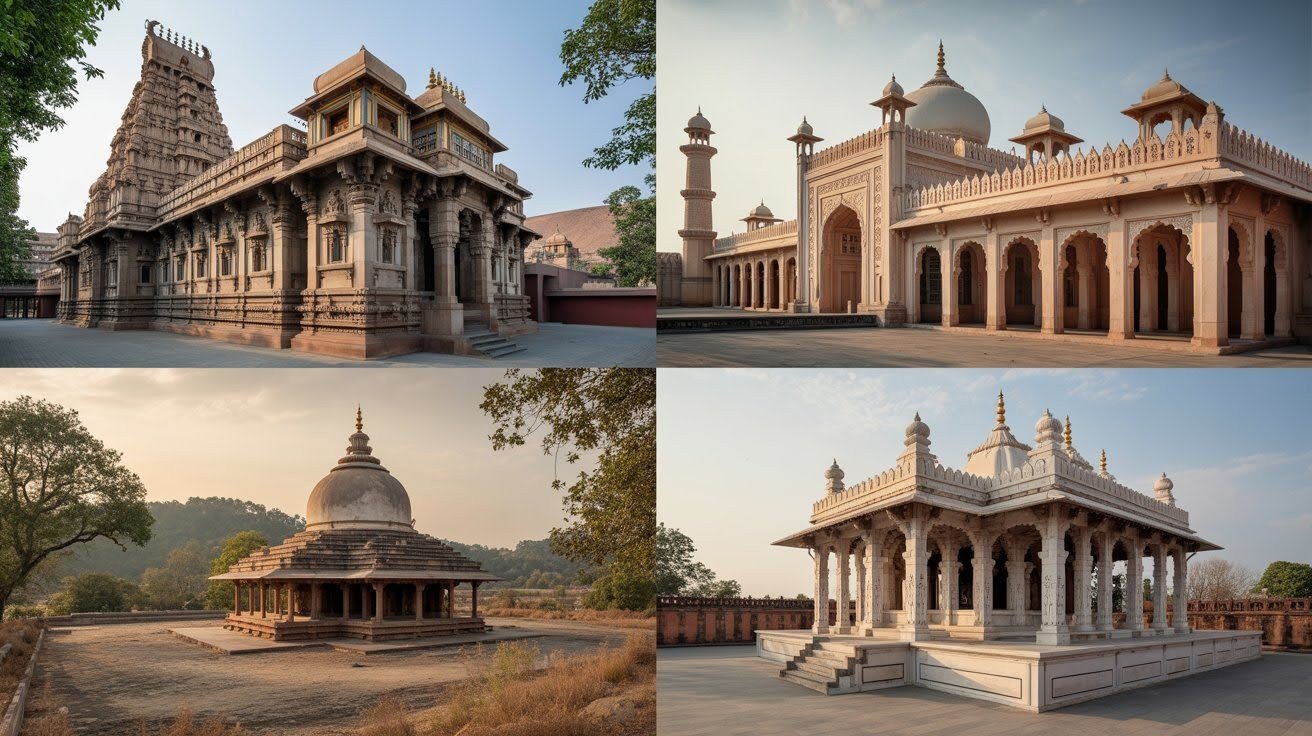
Indian Temples: Indian temples are like stone encyclopedias. Every surface tells a story. Gods dance across walls. Flowers bloom in carved stone.
The towers reach up like prayers made solid. Inside, dark chambers hold sacred images. Pilgrims walk around them in circles.
Mughal Influence: The Mughals brought Islamic architecture to India. Domes float on slender columns. Geometric patterns replace human figures. Gardens represent paradise on earth.
The Taj Mahal is the crown jewel. White marble changes color with the light. Inlaid flowers look real enough to smell.
Buddhist Architecture: Buddhist buildings focus on meditation. Stupas hold relics. Monks’ cells are simple and plain.
Caves carved into cliffs become temples. The rock itself becomes sacred space.
Southeast Asian Architecture
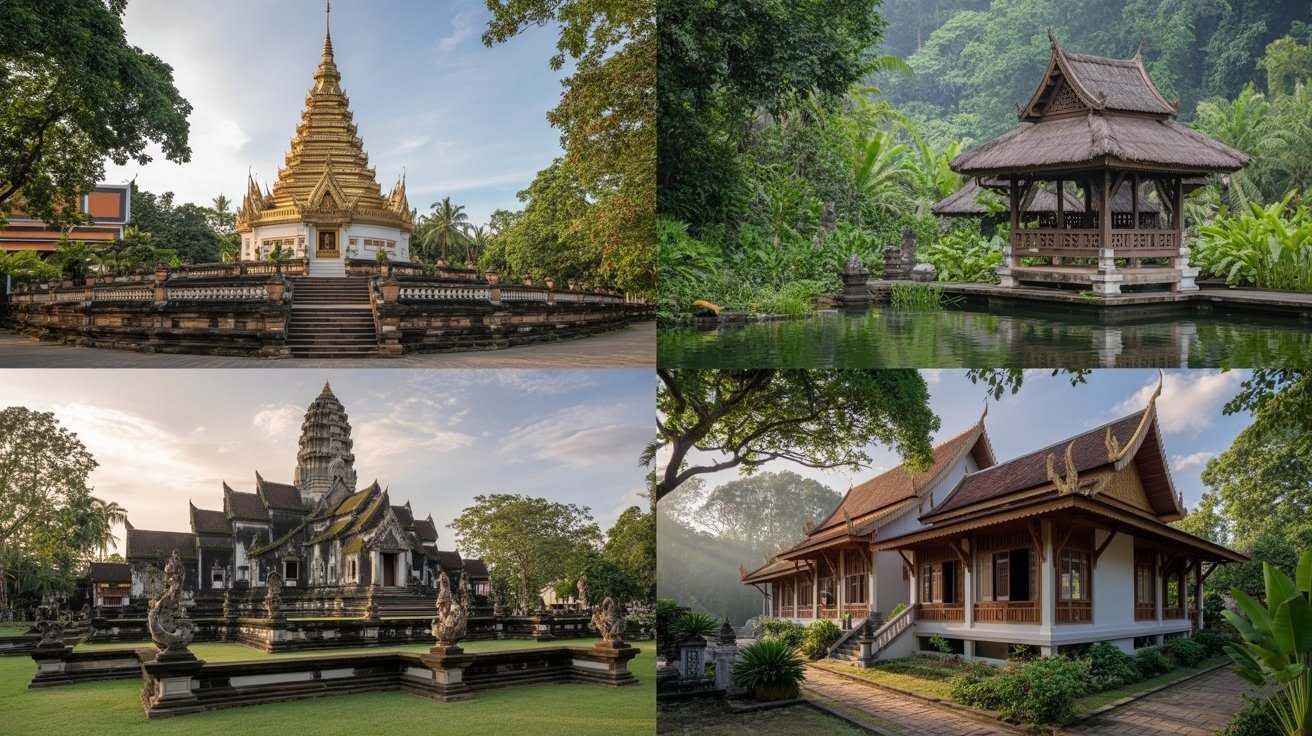
Thai Stupas: Thai stupas stretch toward the sky like golden flames. They hold Buddha’s relics and teachings. Each one is a mountain of merit.
The roofs cascade downward. They protect from tropical rain. They also create shade in the brutal heat.
Balinese Pavilions: Balinese buildings live in the open air. Pavilions (bale) have roofs but no walls. Families gather underneath for ceremonies and daily life.
Split gates mark sacred entrances. They look like a mountain split in half. Gods can pass through the gap.
Khmer Temples: Angkor Wat is Cambodia’s masterpiece. This temple complex maps the Hindu universe in stone. The central tower is Mount Meru, home of the gods.
Galleries tell epic stories. Apsaras (celestial dancers) move across the walls. Water mirrors the sky.
Central Asian & Middle Eastern Influences
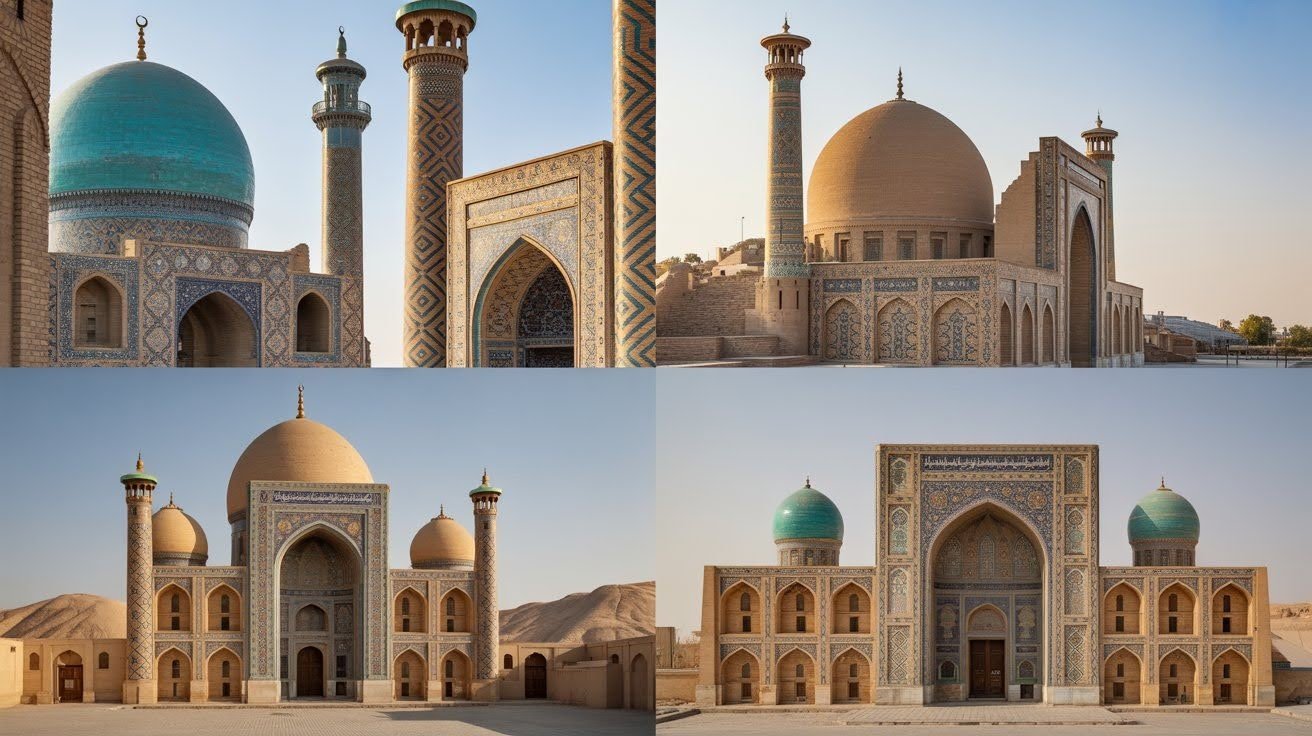
Domes and Minarets: Islamic architecture brought domes to Central Asia. They seem to float weightless above prayer halls. Minarets call believers to prayer five times daily.
Persian Tiles: Persian artisans covered buildings in glazed tiles. Blues and turquoises cool the eye. Geometric patterns create infinite designs.
Silk Road Fusion: Trade routes mixed architectural styles. Chinese roofs met Persian domes. Indian carvings blended with Islamic geometry.
Key Symbols and Their Meanings
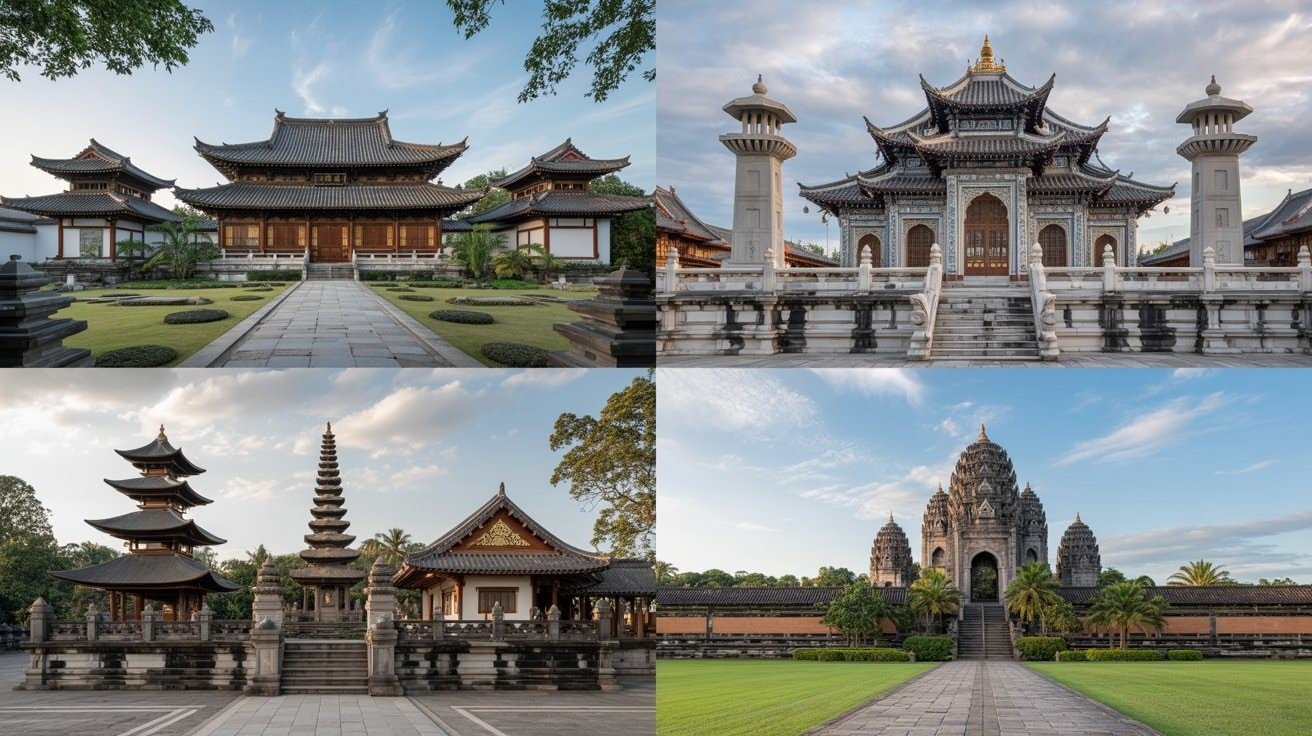
Creature Symbols
Dragons: In Asia, dragons bring good luck. They control water and weather. You’ll see them on roof ridges and door frames.
Chinese dragons have four legs. Japanese dragons have three. Korean dragons can have four or five.
Lotuses: The lotus grows from mud but blooms clean. It represents purity and enlightenment. You’ll find lotus patterns everywhere in Buddhist architecture.
Elephants: Elephants symbolize strength and wisdom. In Hindu temples, they guard entrances. In Buddhist buildings, they represent the Buddha’s birth.
Guardian Lions: Stone lions protect temples and palaces. They come in pairs – one male, one female. The male plays with a ball. The female protects a cub.
Roof Shapes and Meanings
Curved Roofs: Curved roofs aren’t just beautiful. They channel rain away from buildings. They also lift energy upward toward heaven.
The curves get steeper near the edges. This creates an optical illusion. The roof seems to float.
Hip Roofs: Hip roofs slope down on all four sides. They represent stability and protection. Imperial buildings often use this style.
Color Symbolism
Red: Red means joy and good fortune. It’s the color of celebration and power. Imperial palaces use lots of red.
Gold: Gold represents the divine. It’s the color of Buddha images and temple decorations. It never fades or tarnishes.
White: White symbolizes purity and mourning. It’s the color of simplicity and truth. Buddhist temples often use white.
Green: Green represents nature and growth. It’s the color of jade and spring. Gardens and courtyards feature lots of green.
Black: Black means mystery and depth. It’s the color of ink and night. Calligraphy and roof tiles often use black.
Sacred Geometry
Symmetry: Most Asian buildings are perfectly balanced. The left side mirrors the right. This creates harmony and peace.
Orientation: Buildings face specific directions. Temples face east toward the rising sun. Palaces face south toward warmth.
Proportions: Nothing is random. Column heights follow mathematical ratios. Room sizes relate to human body measurements.
Cultural and Spiritual Significance
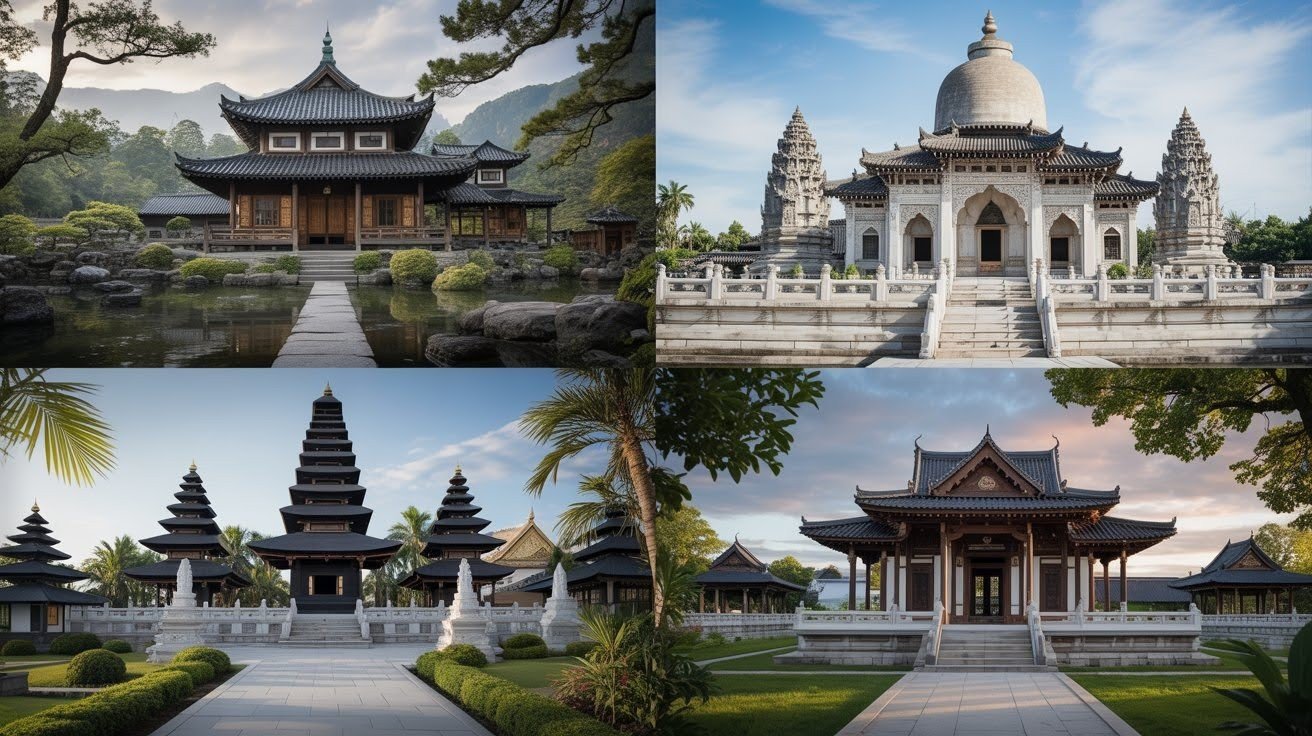
Buddhism
Buddhist architecture creates spaces for meditation. Stupas hold relics of the Buddha. Temples house sacred texts and images.
The buildings themselves teach. Walking around a stupa is like reading a book. Each step brings you closer to enlightenment.
Hinduism
Hindu temples are homes for gods. The inner sanctum (garbhagriha) is like a womb. Devotees enter to be reborn spiritually.
The temple tower represents Mount Meru, center of the universe. Circumambulation (walking around) honors the divine.
Confucianism
Confucian buildings emphasize order and hierarchy. The emperor’s palace sits at the center. Lesser buildings surround it in ranks.
Ancestral halls honor family lineage. The dead continue to guide the living.
Taoism
Taoist buildings work with natural forces. They bend instead of breaking. They follow the land’s contours.
Gardens represent the natural world in miniature. Rock, water, and plants create perfect balance.
Islam
Islamic architecture in Asia blends Middle Eastern traditions with local styles. Mosques face Mecca. Minarets call believers to prayer.
Geometric patterns represent the infinite nature of Allah. Calligraphy turns words into art.
Architecture as Storytelling
Every building tells a story. Temple walls show religious epics. Palace halls display royal genealogies. Even simple homes carry family histories.
The stories aren’t just decorative. They teach moral lessons. They preserve cultural memory. They connect the present to the past.
Cosmic Order
Asian buildings map the universe. The roof is heaven. The floor is earth. Pillars are the axis connecting them.
This isn’t just symbolism. It’s a way of understanding reality. Buildings become microcosms of the entire cosmos.
Asian Architecture in the Modern World
- Contemporary Integration: Modern Asian builders don’t just copy the past. They translate old ideas into new forms. Traditional courtyard houses become apartment complexes. Ancient roof curves inspire skyscraper profiles.
- Preservation Efforts: Many old buildings are disappearing. Rapid development threatens heritage sites. But preservation efforts are growing stronger.
- Adaptive Reuse: Old buildings get new purposes. Temples become cultural centers. Palaces become museums. Traditional houses become boutique hotels.
- Global Influence: Asian building styles influence the world. Zen gardens appear in corporate offices. Feng shui guides urban planning. Traditional building techniques inspire sustainable design.
Why Asian Architecture Still Matters Today
- Asian buildings were eco-friendly centuries before modern green design, using local materials and working with climate.
- Modern builders learn from ancient techniques like passive cooling, natural ventilation, and earthquake-resistant construction.
- These structures serve both physical needs and spiritual well-being, creating spaces that heal and inspire.
- In our globalized world, they provide cultural identity and encourage mindfulness and reflection.
- Asian buildings evolved in diverse climates, offering urgent lessons for climate change challenges.
- They remind us that balance, harmony with nature, and respect for human spirit never go out of style.
Conclusion
Asian building styles are more than just structures. They’re a way of seeing the world. They show us how humans can create beauty while honoring nature and spirit.
From Chinese pagodas to Indian temples, from Japanese tea houses to Islamic mosques, each style offers unique insights. They teach us about balance, harmony, and the connection between earth and sky.
These buildings survived wars, earthquakes, and centuries of change. They endure because they’re built on solid principles. They respect their environment. They serve human needs while lifting the human spirit.
As we face modern challenges, Asian building styles offer solutions. They show us how to build sustainably. How to create spaces that heal. How to honor the past while embracing the future.
Frequently Asked Questions
What makes Asian architecture different from Western architecture?
Asian architecture emphasizes harmony with nature and spiritual symbolism. While Western buildings often dominate their surroundings, Asian buildings work with them. They use natural materials, follow environmental conditions, and incorporate religious and philosophical meanings into their design.
Why do Asian buildings have curved roofs?
Curved roofs serve both practical and spiritual purposes. They efficiently shed rain and snow while creating visual appeal. Spiritually, the upward curves lift energy toward heaven and represent the connection between earth and sky.
What do the colors in Asian architecture mean?
Colors carry deep symbolic meaning. Red represents joy and good fortune. Gold symbolizes the divine and never-fading truth. White means purity and simplicity. Green represents nature and growth. Black signifies mystery and depth.
How do Asian buildings survive earthquakes?
Traditional Asian architecture uses flexible wood joinery and foundation systems that bend rather than break. Pagodas and temples can sway with earthquakes without collapsing. The buildings “breathe” with natural movements.
Can modern buildings use Asian architectural principles?
Yes, many contemporary architects incorporate Asian principles like natural ventilation, climate-responsive design, and harmony with surroundings. These ancient techniques often prove more sustainable and comfortable than modern alternatives.


